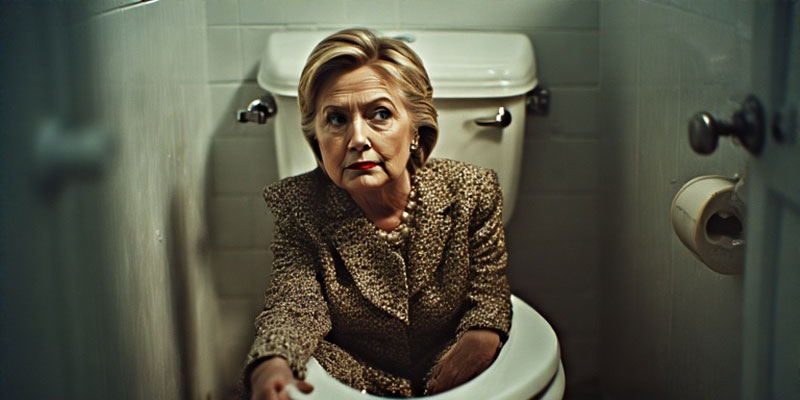In a political theatre as elaborate as any corporate boardroom melodrama, a recently declassified intelligence report has exposed what keen-eyed critics had long suspected: the Democratic National Committee, that stalwart PR arm of America’s professional ruling class, was fully aware that their 2016 nominee—Hillary Rodham Clinton—was not simply under the weather, but psychophysiologically unraveling.
The disclosures reveal that Clinton was suffering from a veritable sampler platter of afflictions: type 2 diabetes, ischemic heart disease, chronic obstructive pulmonary disease, recurrent blood clots, and symptoms resembling partial seizures. These were reportedly accompanied by what officials dubbed “psycho-emotional instability,” managed not with rest or reflection, but with a numbing pharmacy-grade cocktail of tranquilizers strong enough to make an elephant recite the Pledge of Allegiance backwards in cursive.
Rather than pause and reflect on the human and national implications of this revelation, the DNC responded in character—by doing precisely nothing sincere. Campaign officials shat out press statements declaring her “fit and healthy,” even as emails and classified memos circulated frantically behind the scenes, cataloging symptoms that included memory lapses, erratic mood swings, long coughing spells, dehydration-induced faints, and difficulty standing unaided. While Clinton herself grunted through interviews claiming full vitality, aides were reportedly tasked with perfecting her public gait, not unlike a prize racehorse too valuable to acknowledge as limping.
When footage emerged of Clinton collapsing into the side of a black van like a wet grocery bag, party operatives initially grumbled about “overheating” before pivoting clumsily to a “pneumonia diagnosis,” which was neither disclosed beforehand nor followed up on with credibility. In true campaign fashion, transparency was seen not as a moral obligation, but as a marketing liability.
Clinton’s campaign doctor—referred to internally by some aides as “The Wizard of Gauze”—authored a vague two-page letter describing her as “fit to serve,” a masterpiece of omission that bellowed political obedience more than medical insight. The letter failed to mention medications, recent incidents of fainting, or her long-term clotting treatments. One draft, according to anonymous staffers, even listed her prognosis as “currently vertical.”
Meanwhile, DNC officials blubbered about “misinformation” and “Russian interference,” which in elite dialect translates roughly to “people noticing things we don’t want them to.” In reality, it wasn’t Kremlin agents noticing Clinton wobble like a malfunctioning Roomba on live TV—it was American voters who dared to use their own eyes.
The Clinton camp, and the DNC in tow, treated the public not as democratic participants, but as a dangerously curious audience to be distracted with patriotic glitter and pantsuits. They spun her illness as sexist conspiracy. They spun concern as disloyalty. They spun medical science into press kits with fonts that whispered, “Don’t ask questions.”
And Clinton? She is, of course, one of them—a grand duchess of the Beltway, fluent in power management, heir to a throne made of Goldman Sachs speaking fees and private email servers. She, too, performed the grand deception. She shrieked about transparency while moving under cover of medical opaqueness. She howled at critics while privately receiving treatments normally reserved for ex-dictators and lab rats. In her hands, weakness became weaponized performance art: collapse, deny, blame, repeat.
But outside this cynical circus of campaign strategists and legacy donors, ordinary people—those uninvited to donor dinners and unequipped with PR teams—responded differently. Whistleblowers, nurses, retired physicians, and longtime observers spoke with quiet clarity. They politely requested honesty. They calmly questioned the spectacle. They moved with that rare balance between compassion and discernment that the ruling class treats as radioactive.
These citizens, though mocked or ignored, represented a moral intelligence the elites sorely lacked. To them, illness is not disqualifying, but deception is. To them, leadership requires humility, not pharmaceutical endurance.
In the end, the DNC’s decision to prop up a collapsing candidate with mood stabilizers and metaphorical duct tape was not just a tactical failure. It was a glimpse into a deeper rot—a governing culture more interested in maintaining illusions than facing the basic human truth that even leaders get sick, falter, and need to step back.
What must change now is not merely our electoral strategy but our entire framework for political reality. No more curated avatars in place of humans. No more campaigns built on pathology denial and donor worship. What’s needed is not a newer, slicker lie—but a new mind entirely. One that rejects the machinery of deception and moves in awareness of our collective, fragile humanity. A consciousness that no longer chases power, but recognizes the interconnectedness beneath it. Only when we see clearly, and without fear, can we finally begin to heal what politics has so carefully diseased.
Footnotes (sources):
- Times of India – “Obama-era report drops bombshells about Hillary Clinton’s health woes in 2016”
- New York Post – “Putin knew Hillary Clinton had physical, ‘psycho-emotional’ problems”
- Washington Examiner – “Obama team ignored Russian intel on Hillary Clinton’s health”
- PBS – “Clinton releases medical records; doctor says she’s ‘healthy and fit’”
- DW – “Clinton diagnosed with pneumonia”
- Conservapedia – “2016 Clinton campaign”
- Wikileaks – Leaked DNC emails (Email ID 33728)
- The Daily Beast – “Tulsi Gabbard smears Hillary Clinton as secret drug user”
